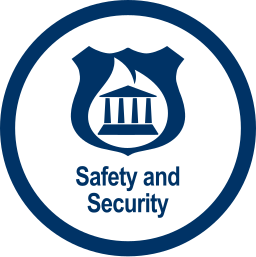A lifeline enables the continuous operation of critical government and business functions and is essential to human health and safety or economic security.
- Lifelines are the most fundamental services in the community that, when stabilized, enable all other aspects of society to function.
- FEMA has developed a construct for objectives-based response that prioritizes the rapid stabilization of Community Lifelines after a disaster.
- The integrated network of assets, services, and capabilities that provide lifeline services are used day-to-day to support the recurring needs of the community and enable all other aspects of society to function.
- When disrupted, decisive intervention (e.g., rapid re-establishment or employment of contingency response solutions) is required to stabilize the incident.
Download the Community Lifelines Toolkit

Safety and Security - Law Enforcement/Security, Fire Service, Search and Rescue, Government Service, Community Safety

Food, Water, Shelter - Food, Water, Shelter, Agriculture

Health and Medical - Medical Care, Public Health, Patient Movement, Medical Supply Chain, Fatality Management

Energy - Power Grid, Fuel

Communications - Infrastructure, Responder Communications, Alerts Warnings and Messages, Finance, 911 and Dispatch

Transportation - Highway/Roadway/Motor Vehicle, Mass Transit, Railway, Aviation, Maritime

Hazardous Material - Facilities, HAZMAT, Pollutants, Contaminants
Why We Use Community Lifelines
FEMA created Community Lifelines to reframe incident information, understand and communicate incident impacts using plain language, and promote unity of effort across the whole community to prioritize efforts to stabilize the lifelines during incident response.
While lifelines were developed to support response planning and operations, the concept can be applied across the entire preparedness cycle. Efforts to protect lifelines, prevent and mitigate potential impacts to them, and building back stronger and smarter during recovery will drive overall resilience of the nation.
Community lifelines were tested and validated by federal, state, local, tribal and territorial partners in the aftermath of hurricanes Michael (Oct. 2018), Florence (Sept. 2018) and Dorian (Aug. 2019), Super Typhoon Yutu (Oct. 2018), the Alaska earthquake (Dec. 2018) and the coronavirus (COVID-19) pandemic (2020). They were formalized in the National Response Framework, 4th Edition.

For information on implementing lifelines during incident response, go to the Community Lifelines Implementation Toolkit 2.0.

